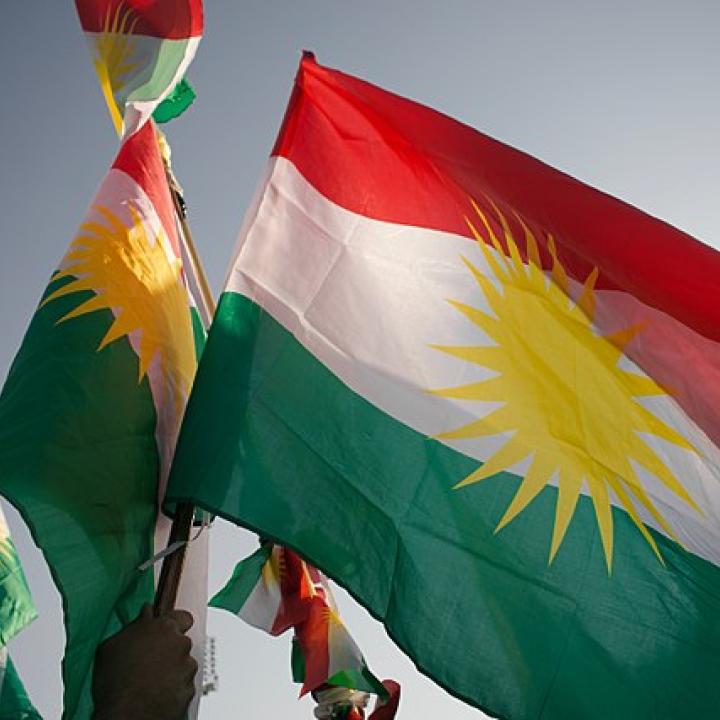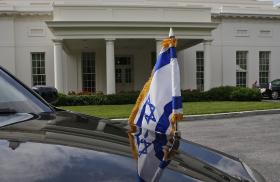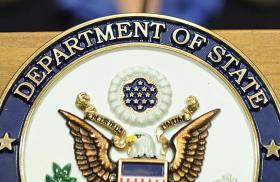
- Policy Analysis
- Fikra Forum
Caution and Fear of a Crackdown: Iranian Kurdish Opposition Responses to the Israel-Iran Conflict

Iranian Kurdish opposition groups remain committed to regime change in Iran, but external and internal factors contributed to the caution with which they approached the recent conflict.
In the immediate aftermath of Israel’s recent strikes on Iran and its calls for regime change, major Iranian Kurdish opposition groups issued several statements, condemning the Islamic Republic of Iran but not necessarily espousing the war’s aims. As opposition groups that have fought against the Islamic Republic for decades—Ayatollah Khomeini issued a fatwa for jihad against the Kurdish parties in Iran in 1979—each statement echoed a longstanding stance of the respective group. Nevertheless, the Iranian Kurdish parties responded to Israel’s calls for immediate regime change with caution and suspicion. Now that a ceasefire has been declared, they fear a crackdown in Kurdish areas of Iran in the aftermath of the conflict, in line with previous periods when Iranian Kurdish areas have become scapegoats for the regime.
The Development of Iranian Kurdish political parties
There are several Iranian Kurdish parties based in exile in Iraqi Kurdistan since the 1980s—when most of them were exiled after losing the battle against the regime in the aftermath of the 1979 revolution. Despite possessing a common vision for greater Kurdish agency in Iran, these groups have distinct ideological drives and dynamics that influenced their responses to the conflict. It is difficult to assess any one party’s popularity inside of Iranian Kurdistan—or indeed that of the Iranian Kurdish opposition in general. However, the fact that they have been able to mobilize shopkeepers to close their stores in general strikes on a regular basis, such as during the Jina (Mahsa) Amini protests in 2022, suggests they still enjoy an important base of support within Iranian Kurdistan.
Two of the oldest parties are the Democratic Party of Iranian Kurdistan (PDKI), established in 1945, and the Komala Party, formed in 1969. The PDKI’s traditional support base is in the Mukriyan area—which includes the towns of Mahabad, Bokan, Sardasht, and Oshnavieh—and it advocates for a federal and democratic Iran. The Komala party’s platform, developed by Kurdish students and intellectuals in Tehran, roots itself in secular and democratic tenants and Kurdish self rule in a unified Iran. It subsequently developed a support base is in the Sanandaj-Marivan area. However, the Komala party has since divided has since divided into at least two branches, all based in Sulaymaniyah, with different ideological bents: the Iranian Communist Party led by Ibrahim Alizadeh, and the Komala Party of Iranian Kurdistan led by Abdullah Mohtadi.
Other more recently founded parties are closely connected to Kurdish movements active elsewhere in the region. The Kurdistan Free Life Party (PJAK)—affiliated with the now dissolved Kurdistan Workers’ Party (PKK)—was established in 2004 and follows the PKK’s ideology of democratic confederacy. The Obama administration listed the group as a designated terrorist organization in 2009, and PJAK reached a ceasefire agreement with Iran in 2011. The group has been active in Kermanshah and Ilam provinces, and also Kurmanji-speaking areas—the Kurdish dialect which is mainly spoken in Syria, and Turkey—around Urmia. Although the PKK has announced it will disband in May, the PJAK has stated they will not lay down their weapons.
Another party—originally known as Revolutionaries Union of Kurdistan when it was established in 1991 and rebranded as the Kurdistan Freedom Party (PAK) in 2006—is led by Hussein Yazdanpanah and is one of the more nationalist Kurdish parties, aiming to liberate Kurdistan from ‘colonialism’ and to establish a national Kurdish state. Unlike most other Kurdish Iranian opposition groups that are based in either PUK territory or in both KDP and PUK territories, this party is solely based in the Erbil province and enjoys good ties to the area’s ruling Kurdistan Democratic Party (KDP), joining their fight against ISIS and also defending Erbil in 2017 against Iran-backed PMF and the Iraqi army.
Several other smaller groups also exist. These include reports of Islamist movements and the Organization of Iranian Kurdistan Struggle led by Baba Sheikh Hosseini, which says it struggles for Kurdish autonomy and a democratic and parliamentary political system and has some ties to the Mojahedin-e-Khalq. Nevertheless, the four parties discussed above—PDKI, Komala, PJAK, and PAK—represent the most active and visible aspects of Iranian Kurdish politics.
Renewing Calls for Regime Change, with Caution
While each party advocates for a change in regime as part of their platform, their public approaches to the initial Israeli strikes differed significantly. On June 13, PAK welcomed the Israeli attack on the Islamic Republic and called for a nationwide uprising. The KDPI and Komala were more circumspect. The KDPI also called for the removal and ending of the regime on X, indicating that the conflict was “the result of the policies of the Islamic Republic,” while Abdullah Mohtadi—leader of the most active branch of the Komala party—likewise blamed the regime for the crisis.
By contrast, PJAK opposed the war and criticized both Israel and Iran while calling for a self-rule in the style of its Syrian sister party, the Democratic Union Party (PYD). Shamal Bishir, a former PJAK member, explained the likely reasoning behind this stance in an interview conducted during the conflict: “PJAK is careful not to allow its inactivity to open opportunities for rivals such as the KDPI, while also avoiding premature action that could jeopardize the chance of achieving a political arrangement similar to what the PYD negotiated with the Assad regime.” PJAK rhetoric also sought to appeal to Iranian public opinion: “At the same time, as Iranian society becomes increasingly polarized between factions supporting the war and those siding with the regime and denouncing Israel, PJAK seeks to position itself as a 'third alternative.'”
Bishir added that regardless of rhetoric, most Kurdish political parties are reticent to have too public a role or act too quickly in the early stages of any potential for regime change, as was visible in their responses to the conflict. First, they hold the belief that a successful uprising must start in Iran’s major cities, such as in Tehran, rather than in the areas where they enjoy support. Isolated protests in Kurdish areas—as with other minority areas of Iran—are at much higher risk of harsh regime crackdowns.
Komala leader Abdullah Mohtadi likewise emphasized during the conflict the challenges inherent in taking discrete steps towards regime change; “even before the Israeli attack, the uprising was possible, but nobody has called for an uprising in (Iranian) Kurdistan, and the people are waiting and seeing. People are cautious and they are afraid of brutal reprisals by the regime.” PAK spokesperson Khalil Nadri echoed this point: “As for the uprising, our people, our nation rose up in Jina (Amini) revolution and no one backed us up.”
Mohtadi also highlighted how this need for a national movement impacts Komala’s approach to coalitions with other Iranian groups, noting that it is not sufficient for Kurds to have relations with other politically active minorities, such as Baluch or Ahwazi Arabs: “You need the support of the vast majority of the Iranian people—the Persian-speaking population and others. It has to be on a national scale.”
Separate from the challenges inside Iran, Iranian Kurdish parties are likewise constricted by the realities of their exile status as guests in the Kurdistan Region of Iraq (KRI). The political leaders of the KRI looked to stay out of the conflict between Israel and Iran due to fears of an Iranian response similar to the ballistic missile strike that killed prominent Kurdish businessman Peshraw Dizayee on January 15, 2024. Iran has also targeted Iranian Kurdish parties with assassinations, drones, and missile strikes since 2018, including during the Jina Amini protests in 2022. To this end, the KRI Presidency condemned the Israeli attack on Iran and the KRI President arranged a phone call with the Iranian Foreign Minister Abbas Araghchi on June 17. KDP leaders likewise quickly welcomed the Iran-Israel ceasefire when it was announced. This position was also positively welcomed by Iran’s state media, who praised KRI President Nechirvan Barzani for playing “a significant role” in curbing the movements of Iranian Kurdish parties.
The KRI also has a formal commitment to disarming Kurdish Iranian opposition groups; in March 2023, Iraq signed a border security agreement with Iran to disarm these opposition parties and remove them from the border. After the conflict began, KRI President Nechirvan Barzani reiterated the KRI’s dedication to upholding the agreement, and Komala leader Mohtadi emphasized that it remained in place: “The security agreement and its demands are there. Nothing has changed. We haven't had any significant movement to breach that agreement.” While explaining that Komala still has offices in the Iraq-Iran border areas, he stated that Komala “has not crossed the border for many years now” despite Tehran’s periodic claims to the contrary.
However, not all Iranian Kurdish parties deal with the same restrictions in the KRI. While PJAK has maintained its independently negotiated ceasefire with Iran since 2011, it operates in areas outside KRG control, primarily in PKK-held territories in the Qandil mountains along the Kurdish region of the Iraq-Iran border. As Bishir describes the arrangement: “Iranian Kurdish parties have been largely disarmed and confined to refugee camps in Sulaymaniyah as a result of a security agreement between the Iraqi government and the Iranian regime… PJAK is the only organization with an operational military presence inside Iran’s rural areas.” Other Kurdish parties also claim to have operational units that could be activated if needed.
Adding to these externally imposed restrictions, many Kurdish opposition parties expressed distrust regarding Israeli claims of a desire for regime change issued during the war. As PAK spokesperson Khalil Nadri put it, “We have no contact with Israel nor with the United States. There’s no alternative for the regime and there’s no clear indications of what the outcome will be.”
The perception that Israel backs Reza Pahlavi, son of the deposed shah, and its conspicuous silence on the issue of Kurdish or minority rights in Iran—in contrast to its outspoken support for them in Syria—has likewise influenced Iranian Kurdish perceptions of Israel’s potential role in a regime change scenario in Iran. Persian monarchists espouse a vision of a centralized Iran far different from the Kurdish advocacy for greater autonomy, limiting the ability or willingness of the two opposition groups to coordinate. While Mohtadi was initially part of the opposition Alliance for Freedom and Democracy in Iran that formed in 2023 in response to the Jina Amini protests and included Pahlavi, this opposition coalition quickly broke down.
Assessing the Impact of the Ceasefire in Iranian Kurdistan
Now that the battle between Israel and Iran is over, Iranian Kurdish parties fear a crackdown on Kurds inside Iran. The regime is already in the midst of a massive wave of arrests, with at least 734 people detained across Iran, with at least over 300 of them in Kurdish cities. Many people involved in the anti-regime 2022-2023 are being Jina Amini protests have already been re-arrested. There is also fear of a replication of the mass killings in 1979, when 10,000 Kurds were killed and thousands of Kurds were sentenced to death. “The prospect of a bloodbath remains,” Mohtadi said. “They have arrested many people—not only in Kurdistan but across other parts of Iran—and have started to execute people. This bloodbath must be prevented by the United States and the international community.” The Oslo-based human rights organization Hengaw reported that between June 16 and June 25, 2025, six political prisoners—including two Iranian Kurds and one from Iraqi Kurdistan—were executed in various prisons across Iran.
“We are hoping that the international community in the midst of this conflict does not forget about the repression and the violence that the Iranian regime has started against the Kurds and other ethnic minorities who are seeking freedom,” PAK spokesperson Nadri added.
Imagining a Future Role in Regime Change
So far, there is not any indication of an uprising against the regime in the near future now that the Israel-Iran conflict is over. Nevertheless, during the conflict Mohtadi did not rule out the possibility of a new uprising against the regime. “Of course, there is a high probability. People are suffering from economic hardship, insecurity, repression, and a lack of basic services. Public dissatisfaction is widespread, and the legitimacy of the Iranian regime has been eroding rapidly… In recent years—even before the war—there were already signs and symptoms of collapse. The government was unable to provide basic necessities such as food, gas, bread, fuel, and water. So yes, Iran has been on the brink of an uprising—or at least sustained protest movements—for years now.”
The PDKI’s U.S. representative Arash Saleh likewise argued that “Peshmerga forces have always been ready to play a strategic and stabilizing role in the event of regime collapse.”
So far, there is not any indication of an organized opposition or uprising against the regime in the near future. The current conflict is over; yet were signs of a regime collapse to emerge in the future, Iranian Kurdish parties may seek to play a role in further weakening the regime across the border in Iranian Kurdistan, even if spearheading such an effort without broader support would be seen as dangerous for the Kurdish community inside Iran.
While currently unarmed, some of these parties—such as the PAK—had their forces join the war against ISIS and defended Iraqi Kurdistan in 2017 when Iran-backed armed groups and the Iraqi army tried to enter the Kurdish capital after the independence referendum in 2017. As a result, these groups developed experience working with the U.S.-led Coalition against ISIS and have consequently received training and weapons, which may have given them confidence in their ability to reconstitute militarily in Iranian Kurdistan.
At least privately, such a scenario is on the mind of at least one member of these Kurdish parties; he asserted on condition of anonymity, “The Kurds can become an axis that plays the role of destroying the principles of militarism, state terrorism and fundamentalism in order to democratize the region… and ensure the security of citizens and the freedom of religious and ethnic communities.” While this may be a lofty vision, it highlights how Iranian Kurdish opposition with former or current military components see their potential roles were a national uprising to develop.
For now, there are no immediate signs that the conflict has destabilized the regime to the point that internal collapse is possible. And so as Iran instead cracks down on its perceived internal enemies, Iranian Kurdish parties will likely remain cautious in public while doing what they can to ensure that Kurds inside Iran do not continue to bear the consequences of the war.



